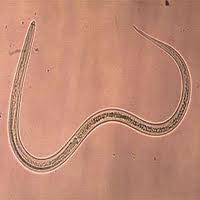Hookworm
Etiology/Bacteriology
Taxonomy
| Domain = Eukaryota | Phylum = Nematoda | Class = Secernentea | Order = Strongylida | Family = Ancylostomatidae | Genus = Necator/ Ancylostoma | species = [[ N. americanus/ A. duodenale]] [1, 2].
Description
The hookworm is a soil-transmitted helminth that is common in many third world and developing countries. There are two species that typically infect human beings—‘’N. americanus’’ and ‘’A. duodenale’’. Hookworms are located in areas with warm, moist climates. Most people with hookworm infections have no symptoms. A few do present symptoms. Serious effects of hookworm can lead to anemia and protein loss.
Pathogenesis
Transmission
An infected human being will have eggs in their stool. Under favorable conditions, 20-30°, the larvae will hatch and mature in 5 to 10 days. If another human walks barefoot on the soil where the larvae reside, they can become infected. (CDC) After 5 or more minutes of skin contact the larvae will penetrate the skin (EMED). After entering the skin larvae penetrate the blood vessels and are carried to the lungs where they penetrate into the pulmonary alveoli. Afterwards, they ascend the bronchial tree and are then swallowed and attach to the small intestine. During this time, the hookworms excrete chemicals that allow them to travel throughout the body—as well as avoid the immune response. N. americanus can only infect by penetration of the host skin. However, ‘’A. duodenale’’ can be ingested and still infect the host.
Clinical Features
Diagnosis
Treatment
Prevention
Host Immune response
1. N americanus genome. http://www.ncbi.nlm.nih.gov/genome/?term=N+americanus
2. NCBI. http://www.ncbi.nlm.nih.gov/Taxonomy/Browser/wwwtax.cgi?name=Necator+americanus
3.
Created by Dane Korber


